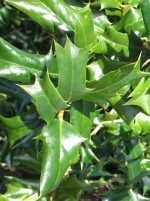 This broad-leaved evergreen shrub from China is popular in gardens because of its very attractive glossy leathery dark green leaves packed into a dense bush. The leaves are 1½-3” long and have one to several distinct spines. The spines may point up or down and look something like horns as suggested by the specific name cornuta. In early spring small white male and female flowers are produced on different plants; bright red berries 1/3 to ½ inch in diameter follow on the female trees in fall. These berries are very showy and berried covered branches are often used in Christmas arrangements. In order to have berries both male and female plants must be located in the same area but one male will be sufficient to pollinate many females. Chinese holly is excellent for foundation plantings and in shrub borders. And because of its dense, compact nature it makes an outstanding hedge, although a prickly one. Many cultivars are available varying in abundance of spines, size, and berry production. The cultivar Burfordii is especially favored because females plants can produce a heavy crop of berries without the help of males, although even more berries when a male is present.
This broad-leaved evergreen shrub from China is popular in gardens because of its very attractive glossy leathery dark green leaves packed into a dense bush. The leaves are 1½-3” long and have one to several distinct spines. The spines may point up or down and look something like horns as suggested by the specific name cornuta. In early spring small white male and female flowers are produced on different plants; bright red berries 1/3 to ½ inch in diameter follow on the female trees in fall. These berries are very showy and berried covered branches are often used in Christmas arrangements. In order to have berries both male and female plants must be located in the same area but one male will be sufficient to pollinate many females. Chinese holly is excellent for foundation plantings and in shrub borders. And because of its dense, compact nature it makes an outstanding hedge, although a prickly one. Many cultivars are available varying in abundance of spines, size, and berry production. The cultivar Burfordii is especially favored because females plants can produce a heavy crop of berries without the help of males, although even more berries when a male is present.
Type: Broadleaf evergreen shrub or small tree
Outstanding Features: Leaves; berries
Form: Upright, rounded
Growth Rate: Slow to moderate
Bloom: Small white male and female flowers are produced in spring on separate bushes.
Size: 4-25’ H x 4-20’ W
Light: Full sun to shade
Soil: Average, moist, well-drained, slightly acidic
Fertilizer: Apply product such as Holly Tone in spring
Hardiness: Zones 7-9
Care: Prune in spring before growth begins
Pests and Diseases: Generally pest and disease resistant but susceptible to tar spot, cankers, scale, mites, and holly leaf miner
Propagation: Semi-ripe cuttings in summer or early fall; seed
Outstanding Selections:
 ‘Burfordii’ (dense, rounded to 10’ tall; does not need males for berry production)
‘Burfordii’ (dense, rounded to 10’ tall; does not need males for berry production) ‘Carissa’ ( 4’ H x 5’ W; dense glob without pruning).
‘Carissa’ ( 4’ H x 5’ W; dense glob without pruning).